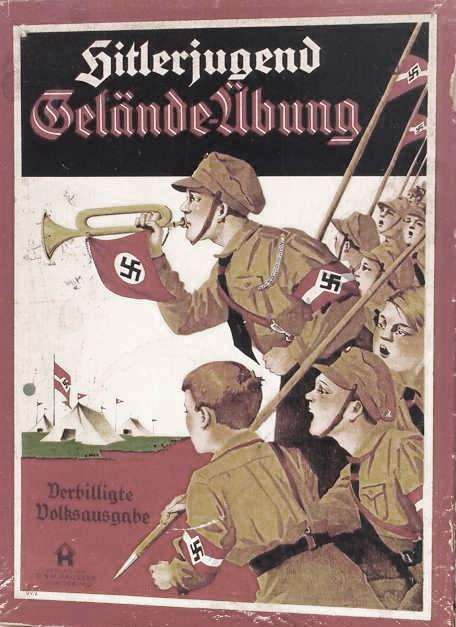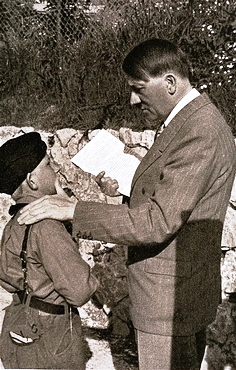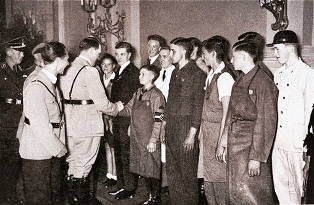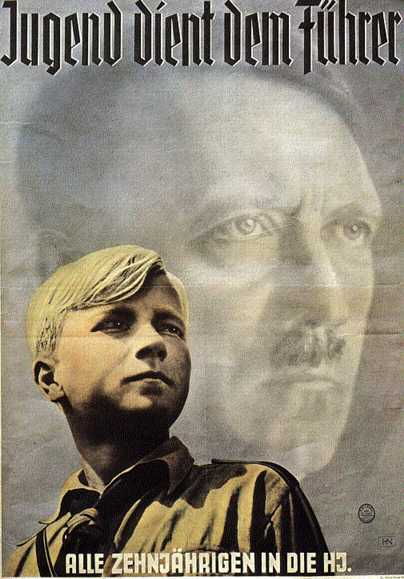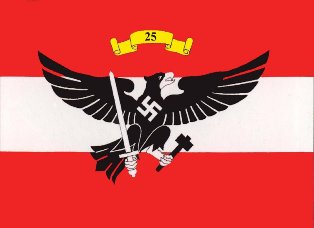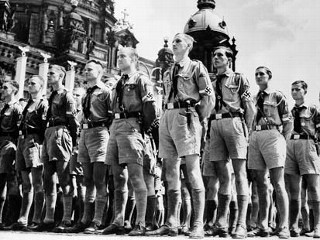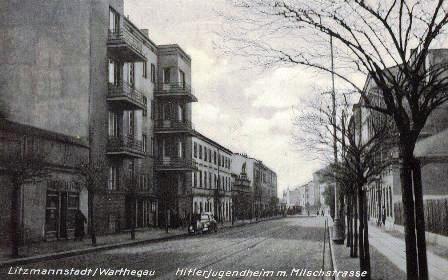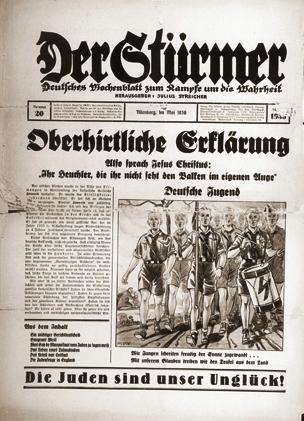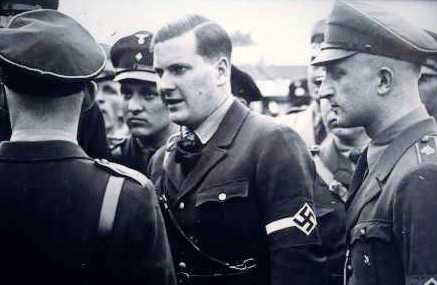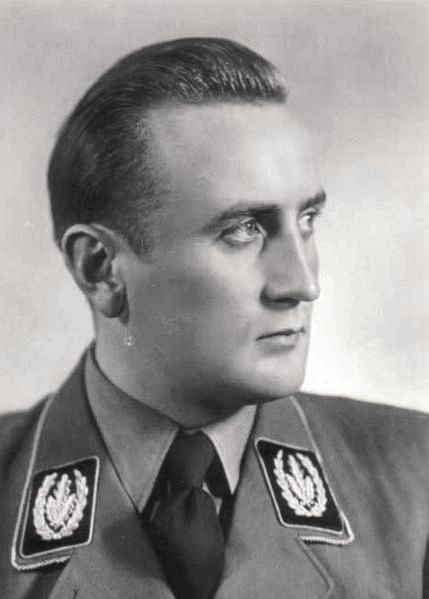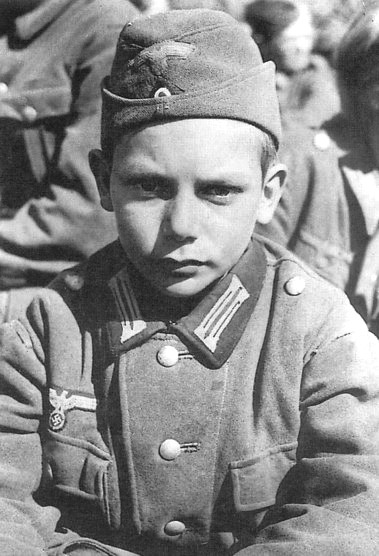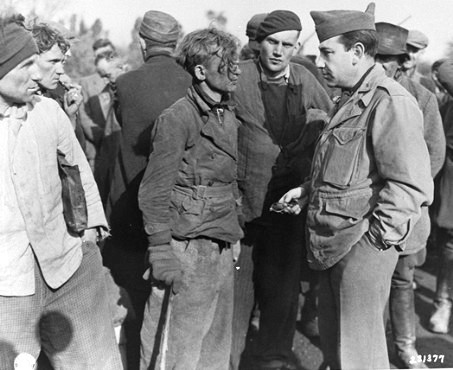Holocaust Education & Archive Research Team |
|
Holocaust Prelude Early Nazi Leaders Nazi Propaganda Nazi Racial Laws Sinti & Roma Kristallnacht The SS SS Leadership Wannsee
Prelude Articles Image Galleries
| |||||||
The Hitler Youth Jungsturm Adolf Hitler
In 1920, Adolf Hitler, authorized the formation of a Youth League of the National Socialist Workers' Party (NSDAP) based upon the principles of an earlier German youth group known as as the Wandervögel. The Wandervögel (translated as "Migratory Bird") were the German equivalent of the Boy Scouts of America and the World Organization of the Scout Movement.
Wandervögel members had an idealistic, romantic notion of the past, yearning for simpler days when people lived off the land. Wandervögel members distinguished themselves by wearing shorts and hiking boots rather than the starched shirts and creased trousers of the middle class. They believed in the importance of rediscovering nature without any modern conveniences. They sang old German folk songs around the campfire and greeting each other by saying "Heil."
This new Nazi Youth League attracted very few members at first, competing against numerous other well-established youth groups, and following the failed Munich Beer Hall Putsch and Hitler's arrest, the Youth League of the NSDAP had been outlawed.
However with Hitler's release from prison and the resurgence of the NSDAP, a new Nazi Youth Party was established and headed by Gustav Lenk. In May 1922 Lenk held a beer hall meeting in Munich, to officially proclaim the foundation of League. The Nazi Youth League was formally established small units were created in Nuremberg and other cities.
The growth of the League was slow at first, and in 1922 assistance came from the party newspaper the Völkischer Beobachter which now called for new members, declaring:
"We demand that the National Socialist Youth, and all other young Germans, irrespective of class or occupation, between fourteen and eighteen years of age, whose hearts are affected by the suffering and hardships afflicting the Fatherland, and who later desire to join the ranks of the fighters against the Jewish enemy, the sole originator of our present shame and suffering, enter the Youth League of the NSDAP..."
In May 1923, Lenk published the first Nazi youth magazine, Nationale Jungsturm, which proved to be a money loser and was subsequently diminished to being merely a supplement of the Völkischer Beobachter.
Gustav Lenk maintained strong convictions on exactly how the League should be managed, and soon had a falling out with the party and its leader Adolf Hitler.
Hitler would tolerate no insurrection within the ranks and Lenk was soon discredited by the party on trumped up charges that he was a traitor and petty thief. Lenk had no recourse and was eventually removed from all party functions and replaced by Kurt Gruber.
Kurt Gruber, who impressed Hitler with his zeal and organizational talent was officially proclaimed as its first leader. On July 4,1926 at a Nazi party rally On Sunday, Gruber's Greater German Youth Movement was renamed as the Hitler Jugend, with the official name being:
Hitler-Jugend, Bund deutscher Arbeiterjugend (Hitler Youth, League of German Worker Youth)
The Hitler Youth was born!
When it originally began, the Hitler Youth was Munich-based only. In 1923, the organization had a little over one thousand members. In 1925, the membership grew to over 5,000. Five years later, national Hitler Youth membership stood at 25,000. By the end of 1932 (a few weeks before the Nazis came to power) it was at 107,956. At the end of 1933, the Hitler Youth had 2,300,000 members.
Kurt Gruber organized the corps under adult leaders, and the general membership comprised boys aged fourteen to eighteen. Gruber initiated new guidelines stipulating that all Hitler Youth members over age 18 had to be Nazi Party members; appointments to high ranking positions required Party approval and Hitler Youths must obey all commands issued by any Nazi Party leader.
By the end of 1927, a further requirement was that Hitler Youths turning 18 had to join the storm troopers. However, this resulted in a shortage of trained leaders within the upper echelons of the Hitler Youth. The Youth Committee of the NSDAP then worked out an arrangement with the SA allowing valuable members to stay in the Hitler Youth past age 18.
The basic unit of the Hitler Youth was the Banne, the equivalent of a military regiment. There were more than 300 throughout Germany, each of a strength of about 6000 youths. Every unit carried a flag of almost identical design, but the individual Bann was identified by its number, displayed in black on a yellow scroll above the eagle's head. The flags measured 200 cm long by 145 cm high.
At the end of 1928, Gruber called for a meeting of the entire Hitler Youth leadership to streamline the organization. That meeting resulted in the addition of a new department for boys aged 10 to 14, later known as the Jungvolk. A separate branch was established for girls, later called the Bund Deutscher Mädel, the League of German Girls, or BDM.
By 1931 Gruber himself ran into difficulties with high ranking members within the NSDAP over his management of the Hitler Youth. He came under fire by SA leader Ernst Röhm who felt the Hitler Youth should be subordinated to the SA. Gruber was often criticized for slow growth of the Hitler Youth ranks when the rest of the party was seeing large increases in membership.
In October of 1931, under increased pressure from Hitler, and Rohm, Gruber resigned as leader of the Hitler Youth and was replaced by the newly appointed Reichsjugendführer (Reich's Youth Leader) Baldur von Schirach.
The Nazis capitalized on the natural enthusiasm of young people, their craving for action and desire for peer approval, hoping, ultimately, each young person would come to regard his or her Hitler Youth or BDM unit as a home away from home,in some case as an alternative to their real home.
Beginning in 1933, every year thereafter was to be given a special theme by the leadership of the Hitler Youth. 1933 was aptly named the "Jahr der Organization" or "the year of organization".
Many of the HJ activities thus centered on such topics as administration, organization, structure, etc. As a reward for his previous years of service, On June 17th, 1933 Hitler elevated Baldur von Schirach to the new position of "Jugendführer des Deutschen Reiches" answerable only to him.
On December 1st, 1936, a law was enacted which made it mandatory for all German youths to be educated according to the philosophies of Nationalist Socialism from the age of 10 and higher. This was called the Reichsjugenddienstpflicht (mandatory youth service) and it essentially legalized the Hitler Youth movement and organization while also neutralizing nearly every other, non Hitler Youth affiliated youth movement.
Schirach's goal in 1936 was to enroll the entire population of ten-year-olds throughout Germany into the Hitler Youth as a present for Hitler on his 47th birthday. 1936 became the "Year of the Jungvolk"
In 1937, a Hitler Youth rifle school was also established. About 1.5 million boys were trained in rifle shooting and military field exercises over the next few years with over 50,000 boys earning a marksmanship medal that required near perfect shooting at a distance of 50 meters. Special Hitler Youth Paramilitary formations for boys eventually included: the Flieger-HJ in which aviation enthusiasts built gliders, participated in annual glider flying competitions, visited Luftwaffe facilities and went for rides in fighters and bombers; the Motor-HJ for boys 16 and older in which they acquired their driver's license and learned to ride motorcycles; and the Marine-HJ in which they obtained sailing certificates, learned river navigation, and participated in naval exercises aboard German training ships.
In September 1938, the last peacetime Nuremberg rally was held. This event was called "Rally of Greater Germany" (Reichsparteitag Großdeutschland), and hosted nearly 700,000 members of various Nazi Party organizations over its weeklong festivities.
On Saturday, September 10, over 80,000 Hitler Youths marched into the city stadium and performed military-style parade maneuvers, which they had been practicing for an entire year, ending with a grand finale in which they spelled out the name 'Adolf Hitler' in the grandstand.
On November 9 1938, a coordinated destruction broke out in cities, towns and villages throughout the Third Reich. In a single night, Kristallnacht saw the destruction of more than 2,000 Synagogues, and the ransacking of tens of thousands of Jewish businesses and homes.
Although predominantly perpetrated by Nazi SA Storm troopers, German women and children also participated in the riots and destruction of Jewish property. When von Schirach learned that Hitler Youth members had indeed engaged in such offensive actions, he issued an order officially forbidding Hitler Youth members from taking part in any similarly minded actions in the future.
By 1939 the Hitler Youth became the largest youth organization in the world with over 7.3 million strong within its ranks. A new law was issued on March 25, 1939, conscripting any remaining holdouts into the organization amid warnings to parents that unless their children were enrolled they would be forcibly removed and placed in the custody of state run orphanages.
In 1940 Baldur von Schirach organized the evacuation of 5 million children from cities threatened by Allied bombing. Not wanting to be left out of the war, received Hitler's permission to volunteer for the army and later that year, he joined the army and volunteered for service in France, where he was awarded the Iron Cross. He was replaced by Artur Axmann as Reichsjugendführer who immediately began to reform the group into an auxiliary force which could perform war duties. The Hitler Youth became active in German fire brigades and assisted with recovery efforts to German cities affected from Allied bombing.
The Hitler Youth also assisted in such organizations as the Reich Postal Service, Reichsbahn, fire services, and Reich radio service, and served among anti-aircraft defense crews.
In 1942, the Hitler Youth established the W-E Lagers. These were special military training camps lasting three weeks in duration. By November of 1942, the Wehrmacht operated 120 W-E Lagers and the SS operated 42 such camps. If all of the Hitler Youth boys at their local school were 17, the whole class was sent to the W-E Lager as a single unit. The year 1943 marked the military turning point for Hitler's Reich. In January, the German Sixth Army was destroyed by the Soviets at Stalingrad and the call to arms amongst the ranks of the Hitler Youth was raised. The result was the formation of the 12th SS-Panzer Division Hitlerjugend. The division was deployed during the Battle of Normandy to be deployed against the British and Canadian forces in the north of Caen. During the following months, the Hitlerjugend division earned itself a reputation for ferocity and fanaticism.
On May 8, 1945, numbering just 455 soldiers and one tank, the 12th SS-Panzer Division Hitlerjugend surrendered to the American 7th Army.
The Hitler Youth formed a major part of the last line of German defense, and were reportedly among the fiercest fighters. The city commander, General Helmuth Weidling, ordered Axmann to disband the Hitler Youth combat formations but the order was never carried out, and many more Hitler Youth died defending Berlin street by street from the ever-advancing Soviet army.
The Hitler Youth was disbanded by Allied authorities as part of the De-Nazification process and many of its leaders were put on trial by Allied authorities for corrupting the hearts and minds of millions of young Germans.
Sources:
The Holocaust Chronicle, Publications International. 2000 Hitler Youth: Growing up in Hitler's Shadow, Susan Campbell Bartoletti 2005 A History of Us: War, Peace and all that Jazz. Joy Hakim, New York: Oxford University Press Berlin: The Downfall 1945, Antony Beevor Penguin Books 2002 The Rise and Fall of the Third Reich William Shirer, Simon & Schuster 1960 The Holocaust Historical Society USHMM
Copyright: Carmelo Lisciotto H.E.A.R.T 2008
|
